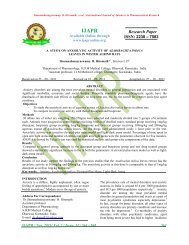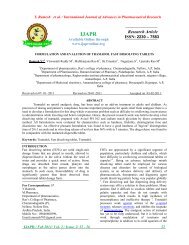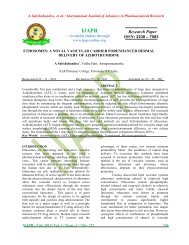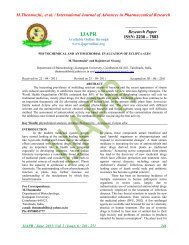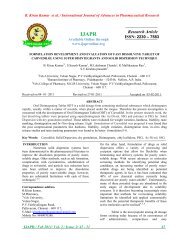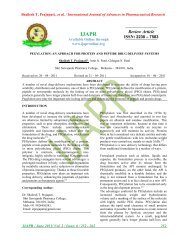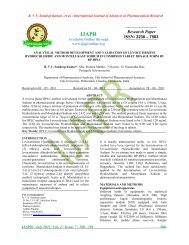international journal of advances in pharmaceutical research
international journal of advances in pharmaceutical research
international journal of advances in pharmaceutical research
Create successful ePaper yourself
Turn your PDF publications into a flip-book with our unique Google optimized e-Paper software.
Phani Ratna Prasanth.G, et al. / International Journal <strong>of</strong> Advances <strong>in</strong> Pharmaceutical Research<br />
dos<strong>in</strong>g is thus necessary to ma<strong>in</strong>ta<strong>in</strong> stable plasma<br />
concentration.<br />
MATERIALS AND METHODS<br />
Materials<br />
Dexlansoprazole, a gift sample from labs <strong>of</strong> Alkem,<br />
sugar spheres, PVP K 30, HPMC E5, dibasic sodium<br />
phosphate, Light magnesium carbonate, sodium<br />
lauryl sulphate, Mannitol, Eudragit L 100 55, HPMC<br />
P 55 PEG 4000, Triethyl citrate, diethyl phthalate,<br />
cetyl alcohol, talc, titanium dioxide, iso propyl<br />
alcohol were obta<strong>in</strong>ed as a gift sample from Alkem<br />
<strong>research</strong> center.<br />
Methods<br />
Preparation <strong>of</strong> Dexlansoprazole 30 mg Delayed<br />
release Pellets<br />
6, 7, 8, 9<br />
Drug load<strong>in</strong>g<br />
Weigh all the <strong>in</strong>gredients as per the given formula <strong>in</strong><br />
table 1 and prepare the drug solution. Take 500 ml <strong>of</strong><br />
purified water <strong>in</strong> beaker and kept for stirr<strong>in</strong>g under<br />
mechanical stirrer. Specified quantities <strong>of</strong> PVP K30,<br />
HPMC E5, dibasic sodium phosphate, Magnesium<br />
carbonate and SLS were added slowly and stir it for<br />
a uniform suspension. Then drug was added <strong>in</strong> the<br />
above solution and stirr<strong>in</strong>g was cont<strong>in</strong>ued for 30<br />
m<strong>in</strong>s to form a vortex <strong>of</strong> the solution. Now pass the<br />
dispersion us<strong>in</strong>g Nylon cloth <strong>of</strong> mesh no 200. The<br />
solution is now ready for drug load<strong>in</strong>g. F<strong>in</strong>ally the<br />
drug is loaded us<strong>in</strong>g the dispersion over sugar<br />
spheres <strong>in</strong> the chamber <strong>of</strong> FBP.<br />
Barrier coat<strong>in</strong>g: (Sub coat<strong>in</strong>g) 5<br />
Sub coat<strong>in</strong>g was done to protect and also for<br />
<strong>in</strong>creas<strong>in</strong>g the stability <strong>of</strong> a drug. Mechanical<br />
strength <strong>of</strong> pellets is also <strong>in</strong>creased. In order to<br />
prevent <strong>in</strong>teraction with functional groups conta<strong>in</strong>ed<br />
<strong>in</strong> the enteric film coat, it is one <strong>of</strong> the advantages to<br />
comb<strong>in</strong>e enteric coat<strong>in</strong>gs with seal<strong>in</strong>g coats made up<br />
<strong>of</strong> cellulose derivatives.<br />
500gm water is taken <strong>in</strong> a beaker and kept it for<br />
stirr<strong>in</strong>g, specified quantities <strong>of</strong> PVP K30, HPMC E5,<br />
dibasic sodium phosphate, magnesium carbonate and<br />
mixed well for 30 m<strong>in</strong>. Add slowly mannitol to the<br />
coat<strong>in</strong>g solution under stirr<strong>in</strong>g for 15 m<strong>in</strong>. After<br />
formation <strong>of</strong> a suspension the solution is ready for<br />
sub coat<strong>in</strong>g and the drug loaded pellets were coated<br />
by us<strong>in</strong>g Fluidized bed coater.<br />
Enteric Coat<strong>in</strong>g 10<br />
Step I: 300ml <strong>of</strong> IPA and 900 ml <strong>of</strong> acetone were<br />
taken <strong>in</strong> a beaker and kept for stirr<strong>in</strong>g under a<br />
mechanical stirrer.<br />
Step II: All the <strong>in</strong>gredients should be weighed<br />
accurately and should be passed through 200# for<br />
proper formation <strong>of</strong> dispersion.<br />
Step III: In another portion <strong>of</strong> solution add talc and<br />
titanium dioxide and stir it.<br />
Step IV: Now step II form was added slowly to step I<br />
and stirr<strong>in</strong>g was done for 20 m<strong>in</strong> until it forms a<br />
uniform mixture. Add plasticizer to the above<br />
dispersion.<br />
Step V: Add dispersion step IV to step III under<br />
cont<strong>in</strong>uous stirr<strong>in</strong>g to form a homogenized mixture.<br />
Now filter through a nylon cloth. Now the filtered<br />
solution is ready for enteric coat<strong>in</strong>g and check the<br />
pH <strong>of</strong> the solution.<br />
Step VI: enteric coat<strong>in</strong>g us<strong>in</strong>g the dispersion <strong>of</strong> step<br />
V over the barrier coated pellets with the help <strong>of</strong><br />
fluidized bed coater. Wurster <strong>in</strong>sert and a bottom<br />
spray gun. Spread <strong>of</strong> the solution was carried out at<br />
at atomization pressure <strong>of</strong> 2 kg/cm 2 , an <strong>in</strong>let<br />
temperature <strong>of</strong> 35 o C, spray rate <strong>of</strong> 6 ml/m<strong>in</strong> and a<br />
fan speed <strong>of</strong> 7 to 9. Up on completion <strong>of</strong> spray<strong>in</strong>g,<br />
the various load<strong>in</strong>g on sugar spheres were further<br />
dried at 60 o C <strong>in</strong>let temperature for 5 m<strong>in</strong> and the <strong>in</strong><br />
process parameters were given <strong>in</strong> table 1. The f<strong>in</strong>al<br />
end product was then sieved on top <strong>of</strong> a 20-mesh<br />
screen to elim<strong>in</strong>ate f<strong>in</strong>es.<br />
Evaluation <strong>of</strong> Pellets 1,12<br />
Evaluation <strong>of</strong> pellets must be done to obta<strong>in</strong> product<br />
performances. Evaluation at different stages dur<strong>in</strong>g<br />
manufactur<strong>in</strong>g process were as follows<br />
Acid resistance: amount <strong>of</strong> drug resisted after 2 hr<br />
<strong>in</strong> acid was 99.75%.<br />
Pellets size analysis: Formulated Dexlansoprazole<br />
delayed release pellets size change dur<strong>in</strong>g different<br />
stages such as drug load<strong>in</strong>g, Barrier coat<strong>in</strong>g and<br />
enteric coat<strong>in</strong>g <strong>of</strong> pellets were shown <strong>in</strong> table no 3<br />
Particle size distribution: This was done for proper<br />
coat<strong>in</strong>g. Particle size was determ<strong>in</strong>ed by us<strong>in</strong>g SEM.<br />
Samples <strong>of</strong> F9 formulation were mounted on metal<br />
tubes and SEM photograph was taken as shown <strong>in</strong><br />
figure 5.<br />
Determ<strong>in</strong>ation <strong>of</strong> drug contents: Enteric coated<br />
pellets <strong>of</strong> Dexlansoprazole 30 mg were transferred to<br />
100 ml vol. flask, added 70 ml <strong>of</strong> methanol and<br />
sonicate for 15 m<strong>in</strong> with <strong>in</strong>termittent shak<strong>in</strong>g and<br />
dilute to volume with methanol. Filter through 0.45µ<br />
filter and further dilute 5 ml <strong>of</strong> this solution to 100<br />
ml with mobile phase. Results were tabulated <strong>in</strong><br />
table 4.<br />
Invitro dissolution studies: An <strong>in</strong>vitro dissolution<br />
study for the f<strong>in</strong>ished product formulation was<br />
carried out us<strong>in</strong>g dissolution USP method I (basket)<br />
for Dexlansoprazole delayed release pellets. The<br />
dissolution medium consisted <strong>of</strong> 900 ml <strong>of</strong> pH 1.2<br />
buffer ma<strong>in</strong>ta<strong>in</strong>ed at a temp <strong>of</strong> 37+0.5 o C and was<br />
run for 2 hr <strong>in</strong>itially and release should not be more<br />
than 10%. Transfer the weighed pellets equivalent to<br />
30 mg <strong>of</strong> Dexlansoprazole <strong>in</strong> to each <strong>of</strong> six jars.<br />
After 2 hrs the previous acid medium was replaced<br />
with 900 ml <strong>of</strong> pH 6.8 buffer and release study was<br />
done.<br />
IJAPR / May. 2012/ Vol. 3 / Issue. 5 / 907 - 913 908



